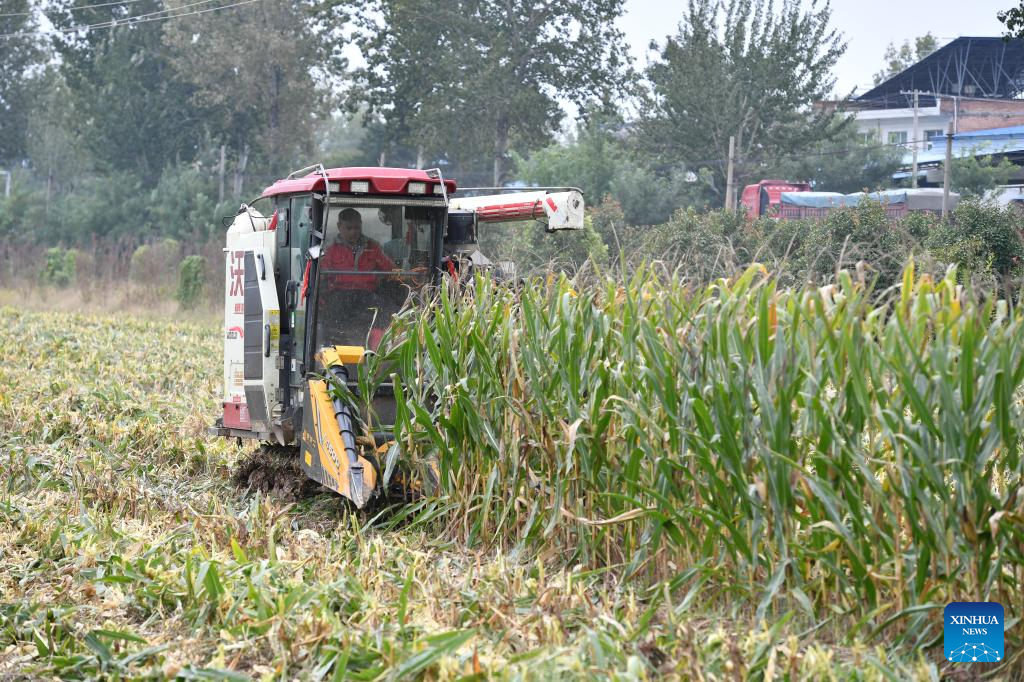Report on Agricultural Resilience and Food Security Initiatives in Shaanxi Province
1.0 Introduction: Mitigating Climate-Related Risks to Food Security
In October 2025, Shaanxi Province implemented a strategic intervention to safeguard its autumn grain harvest against the threat of continuous rainy weather. This initiative addresses the critical challenge of securing food production amidst adverse climate conditions, directly aligning with the principles of the Sustainable Development Goals (SDGs), particularly SDG 2 (Zero Hunger) and SDG 13 (Climate Action).
2.0 Strategic Response and Technological Deployment
To counter the risk of crop spoilage and ensure harvesting efficiency, provincial authorities deployed advanced agricultural technology and established a comprehensive support infrastructure. This response is a clear investment in sustainable and resilient agricultural systems as promoted by SDG 9 (Industry, Innovation and Infrastructure).
2.1 Deployed Agricultural Technologies
- Crawler Harvesters: Specialized machinery designed to operate effectively in wet and challenging terrain, minimizing harvest delays.
- Mobile Grain Dryers: Deployed to rapidly reduce the moisture content of harvested grain, preventing rot and ensuring suitability for storage.
- Color Sorters: Utilized to enhance the quality of the final product by removing impurities.
2.2 Infrastructural Support Network
A robust emergency support system was established to manage post-harvest processing and reduce food loss, a key target of SDG 12 (Responsible Consumption and Production).
- Emergency Operation Teams: A total of 476 teams were mobilized to coordinate harvesting and drying efforts across affected areas, including Sanyuan and Qianxian counties.
- Grain Drying Stations: The province established 765 drying stations to provide widespread access to post-harvest processing facilities.
- Processing Capacity: The network achieved a daily drying capacity of over 70,000 tonnes, providing a solid guarantee for securing the autumn grain supply.
3.0 Contribution to Sustainable Development Goals (SDGs)
The actions taken in Shaanxi Province provide a practical example of integrating sustainable development principles into agricultural management. The initiative makes significant contributions to several key SDGs:
- SDG 2 (Zero Hunger): By preventing large-scale crop loss, the province ensures food availability, enhances food security, and promotes resilient agricultural practices capable of withstanding climate shocks.
- SDG 9 (Industry, Innovation and Infrastructure): The use of modern machinery and the creation of a network of drying stations demonstrate a commitment to building resilient infrastructure and fostering technological innovation within the agricultural sector.
- SDG 12 (Responsible Consumption and Production): The focus on minimizing post-harvest losses is a direct action towards achieving sustainable production patterns and reducing food waste along the supply chain.
- SDG 13 (Climate Action): The entire operation serves as a model for strengthening resilience and adaptive capacity to climate-related hazards, directly addressing the need to protect critical food systems from the impacts of extreme weather events.
Analysis of Sustainable Development Goals in the Article
1. Which SDGs are addressed or connected to the issues highlighted in the article?
- SDG 2: Zero Hunger: The article’s central theme is securing the autumn grain harvest, which is fundamental to ensuring food security and promoting sustainable agriculture. The efforts to improve harvesting efficiency directly contribute to preventing food loss and stabilizing the food supply.
- SDG 9: Industry, Innovation and Infrastructure: The article highlights the development and deployment of infrastructure and technology to support the agricultural sector. The establishment of “765 grain drying stations” and the use of advanced machinery like “crawler harvesters, mobile grain dryers, color sorters” are clear examples of building resilient infrastructure and promoting innovation in an essential industry.
- SDG 13: Climate Action: The actions described are a direct response to a climate-related challenge. The article explicitly states that these measures were taken “to cope with the continuous rainy weather,” which demonstrates a strategy to strengthen resilience and adaptive capacity to climate-related hazards affecting agriculture.
2. What specific targets under those SDGs can be identified based on the article’s content?
-
Under SDG 2 (Zero Hunger):
- Target 2.4: By 2030, ensure sustainable food production systems and implement resilient agricultural practices that increase productivity and production… and that strengthen capacity for adaptation to climate change, extreme weather… The deployment of specialized machinery and drying stations to manage the “continuous rainy weather” is a direct implementation of a resilient agricultural practice designed to adapt to extreme weather and prevent crop loss.
-
Under SDG 9 (Industry, Innovation and Infrastructure):
- Target 9.1: Develop quality, reliable, sustainable and resilient infrastructure… to support economic development and human well-being. The establishment of “476 emergency operation teams and 765 grain drying stations” represents the development of resilient infrastructure specifically designed to support the agricultural economy and the well-being of farming communities.
-
Under SDG 13 (Climate Action):
- Target 13.1: Strengthen resilience and adaptive capacity to climate-related hazards and natural disasters in all countries. The entire initiative described in the article—organizing emergency teams and deploying technology to save the harvest from prolonged rain—is a clear example of strengthening the agricultural sector’s resilience and adaptive capacity to a climate-related hazard.
3. Are there any indicators mentioned or implied in the article that can be used to measure progress towards the identified targets?
Yes, the article provides both explicit and implied indicators:
-
Explicit Indicators: The article provides specific quantitative data that can be used as indicators of progress.
- Number of emergency operation teams established: 476 teams.
- Number of grain drying stations established: 765 stations.
- Daily drying capacity of the infrastructure: over 70,000 tonnes.
-
Implied Indicators: While not stated with a number, the article’s text implies other measurable outcomes.
- Improvement in harvesting efficiency: The stated goal is to “improve the harvesting efficiency,” which could be measured by comparing harvest times or yields with and without these interventions.
- Reduction in post-harvest losses: The use of dryers to manage moisture content directly implies an effort to reduce grain spoilage, a key measure of food loss. The measurement of “moisture content of grain samples” is a direct action related to this indicator.
- Implementation of a local disaster risk reduction strategy: The coordinated response involving teams, machinery, and stations serves as an indicator for Target 13.1, demonstrating a functional strategy to mitigate the impact of a climate-related hazard.
4. SDGs, Targets, and Indicators Summary Table
| SDGs | Targets | Indicators |
|---|---|---|
| SDG 2: Zero Hunger | 2.4: Ensure sustainable food production systems and implement resilient agricultural practices. |
|
| SDG 9: Industry, Innovation and Infrastructure | 9.1: Develop quality, reliable, sustainable and resilient infrastructure. |
|
| SDG 13: Climate Action | 13.1: Strengthen resilience and adaptive capacity to climate-related hazards. |
|
Source: en.people.cn





![[Latest] Europe Energy Management Systems Ems Market Trends to Watch: Growth and Investment – openPR.com [Latest] Europe Energy Management Systems Ems Market Trends to Watch: Growth and Investment – openPR.com](https://cdn.open-pr.com/L/a/La23610616_g.jpg)

